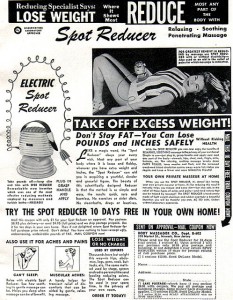Spending Your Wellness Money Well
In my last post, I suggested that it’s easy to mis-spend your wellness dollars for the same reasons many of us participated in the ALS ice-bucket challenge:
- We’re not always clear on our own priorities.

- Powerful, distracting messages conflict with the priorities we might have.
- Wellness initiatives can be complex. Without knowing the most impactful options, we’ll often go with the low hanging fruit presented to us (usually okay but not great).
In this post I’ll review better and worse ways to spend your wellness bucks.
And to say it again, none of this is to disparage ALS the cause or the fund-raising effort. It’s just timely, and there are many positive take-aways from it (see below).
So how do we mis-spend our wellness money? And what should we be spending it on?
I’m talking primarily here about  wellness spending like gym memberships, exercise equipment, food/supplements, etc. And of course that includes the thigh-master (see right). Spending around personal choices and regular activities intended to advance our wellness, and not health care/insurance spending, for example, which primarily mitigates health risks/costs, and which allows your spouse to comfortably f-bomb poor health care administrators around bill reconciliation issues.
wellness spending like gym memberships, exercise equipment, food/supplements, etc. And of course that includes the thigh-master (see right). Spending around personal choices and regular activities intended to advance our wellness, and not health care/insurance spending, for example, which primarily mitigates health risks/costs, and which allows your spouse to comfortably f-bomb poor health care administrators around bill reconciliation issues.
90% of our health relates to choices we make everyday, not investment in health insurance, doctor/hospital fees, etc. Of course it’s not an either-or, but the irony here is that the U.S. spends a TON on insurance (risk mitigation) and cure, and we’re still the most overweight nation on the planet. If you need convincing that the U.S. is uniquely inefficient compared to other countries, you can see just how bad we are here. We’re in this predicament — spending disproportionately on cure/insurance for an unhealthy population — partly because we don’t invest enough or wisely enough on advancing wellness and daily personal choices which support it.
Common Wellness Spends
(some effective, some not so much — and alternatives)
Gym memberships vs. Other Options
If you think a gym membership is the best way to turn around your fitness, exercise (ha) caution. Recent 2014 statistics show that 67% of gym memberships are never used and that $39 out of $58 dollars a month per gym member goes to waste from under-utilization. That might be you flushing $480 out of $720 a year. We all think a membership will jumpstart our New Year’s Resolution, enticed by that actor or fitness model we saw in a magazine or on TV. And to be fair, the gym community buzz, the gym classes, and the personal trainers can all work in your favor. But you gotta show up, and most of us don’t. What are some alternatives?
- If you’re trying to lose weight, a weight-loss program or a wellness coach, along with some of the below options. That might sound self-serving, but big, lasting wellness change typically involves psychological shifts and habit-forming/breaking skills that aren’t generated by a gym membership. See here. You might spend as little as $30 a month or quite a bit more, but it will work, and a wellness coach will help you learn how to sustain the change. Further, a gym membership to lose weight without a diet/nutrition program is like Suzanne Somers without her thigh-master.
- Exercise Classes. Virtues? You get the community, you get workout “buddies” if you don’t already have them, and you get a more compelling reason to get you off your arse than a gym membership. Studies also show that a high-fit buddy will cause you to gravitate toward his/her level of fitness. See more on exercise partners here.
- Work out at home. Hey, it’s not sexy, but resistance is resistance. And your own body + gravity can generate muscle-building resistance just like the big machines or weights you find in a gym. This is particularly true for beginners. See some of the virtues of body-weight training here. Then when you’ve got momentum or have started to plateau, upgrade to a gym membership.
- Cheaper Gyms. Do you really need that plush, expensive ambience — at up to $20k/year — to work up a sweat? Are you living or vacationing or hosting social events there? Are you gym clubbing with Paris Hilton?
 I like the Planet Fitness model — one example, and there are others — which gets you out the door for as little as $120/year. Not bad, and the one I go to has MORE than everything I need, and it’s never over-crowded.
I like the Planet Fitness model — one example, and there are others — which gets you out the door for as little as $120/year. Not bad, and the one I go to has MORE than everything I need, and it’s never over-crowded.
I’m not saying a gym membership has no value. But will a gym membership support your wellness objectives and, if so, how do you know (compared to other options)?
Food, Supplements and Weight Loss Aids
Processed food
For anyone investing in wellness, the single biggest favor you can do for yourself is to stop buying and eating processed food. I realize that few people buy/eat processed food with wellness objectives in mind. But if you’re spending anything on wellness and eating processed food, you’re burning wellness bucks. In 2012 Americans spent 23% of grocery money on processed food, as compared to about half of that in 1982. We’re moving in the wrong direction. We now know that processed foods — soda, snacks, processed grains/bread, margarine, processed meat, etc — are not just “empty calories” (particularly sugars and high glycemic carbs). They actually do your body harm, de-regulating internal systems and generating inflammation. Yes, even Snickers bars. This is bigger than investing in organic food or supplements. Just don’t bring the processed junk into the house, and redirect your spend toward something which is actually promoting, not neutralizing, your wellness.
Quality and Organic Food
Consider that the average American family of four spends more than $2,500 a year on processed food (23% of the total, from above) . Could that be redirected to cover some organic foods, more fresh fruits and vegetables, and higher quality fish/meat (fat and protein, which we already get plenty of)? And would it be worth it even for organics? And could I permanently depose Snickers bars in favor of brussel sprouts? Yes and probably and probably not….

Healthy diets appear to cost about $1.50 a day more than unhealthy ones (2013 data). That’s about $550 annually, a little less than money spent on processed food, so we’re covered there. The nutritional value of more fruits and vegetables and better fish/meat over processed food is indisputable. However, organic vs. non-organic is more controversial. The latest big volley says organics are substantially better. Further, some organic foods are less controversial than others.
Organic agriculture is more environmentally sound over the long term. And Americans don’t pay a lot for food compared to other countries. For those reasons and others, I feel good about investing in organic food. But the first priority is redirecting food spend from processed food to whole foods.
Supplements and Weight Loss Aids
Only three supplements are really proven to be an effective spend: Vitamin D3, Omega-3 fatty acids, and a multi-vitamin. And I might add calcium as a fourth. Details are here and here. These supplements help fill-in nutrition gaps, and others might work well for you. Experimentation rules here. Further, needing a supplement doesn’t mean your diet has failed in the modern world, where soil depletion and food toxins exist. But supplements won’t get you to optimal health without other more important time and money expenditures. So if you’re spending big on supplements and don’t have special requirements, you can probably redirect that money.
Weight loss products and aids are generally useless. Americans spend about $35 billion annually on weight loss scams,  including metabolism boosting pills, fat and carb blocking pills, “slim suits”, herbal weight loss teas, and others. Garcinia cambogia (HCA) is the latest such miracle supplement, which got Dr. Oz wishing he was back in Kansas at a recent congressional hearing. A 2011 article in the Journal of Obesity wrote this about it: “…Garcinia extracts/HCA can cause short-term weight loss. The magnitude of the effect is small, and the clinical relevance is uncertain.” Other studies show similar or no effects. See more here. If you think you’ve found a great weight loss supplement, you can evaluate it using this checklist from the FTC.
including metabolism boosting pills, fat and carb blocking pills, “slim suits”, herbal weight loss teas, and others. Garcinia cambogia (HCA) is the latest such miracle supplement, which got Dr. Oz wishing he was back in Kansas at a recent congressional hearing. A 2011 article in the Journal of Obesity wrote this about it: “…Garcinia extracts/HCA can cause short-term weight loss. The magnitude of the effect is small, and the clinical relevance is uncertain.” Other studies show similar or no effects. See more here. If you think you’ve found a great weight loss supplement, you can evaluate it using this checklist from the FTC.
Sigh. Why are we so gullible on weight loss, and wellness change in general? Because it’s hard and the signs and rewards of progress are slow; anything that appeals to quicker results is going to sell. Which brings me to the last topic and full circle with the ALS ice-bucket challenge….
The Best Wellness Spend(s)
There are only three big major guidelines for spending wellness bucks wisely:
- First things first. You want a Hugh Jackman physique, but you’re 35 pounds overweight, sleeping badly and over-stressed. A gym membership might help, but you won’t get far without directly attending to your sleep, stress and diet. Sleep and stress-management are foundational, because they directly impact general health and motivational fuel, two basic requirements for diet and exercise programs and progress. Spend time and money on them first; they might lead to a gym membership.
- Spend consistent with your vision/goals. I know this is a Captain Obvious statement. But it’s also a common issue. A surprising number of wellness clients are more clear about what they want to leave behind and don’t want, as opposed to what they do want. It’s always more effective to run toward something than away from something. Do you want to lose weight, compete in a triathlon, feel more energetic, create the body to die for, be more serene, or something else? If you aren’t succinct and super clear about your priorities, your spending won’t be efficient, either. For example, if you see triathlons in your future, a bike will probably be a better investment than yoga classes. If you need help discovering or clarifying your wellness goals/vision, wellness coaches and others do that for a living.
- Spend to find/get the fun and build your motivation. The best, most modern and evidence-based theories of behavior change say that you will start and stick with a change program when you: 1) create situation specific self-confidence to succeed (self-efficacy theory) and; 2) get positive reinforcement (operant conditioning). In other words, when you find something that produces fun or satisfaction and gain a sense of
 empowerment to learn/do/achieve it. That’s real motivation that will produce real wellness change. Sounds simple, but often we succumb to superficially attractive options (usually not a good match for us), and/or quit early with frustration because we don’t know how to build and sustain self-efficacy. If you’ve tried and struggled repeatedly to make wellness change, invest in getting some help achieving lasting change you really care about. Again, wellness coaches and others are experts in this arena.
empowerment to learn/do/achieve it. That’s real motivation that will produce real wellness change. Sounds simple, but often we succumb to superficially attractive options (usually not a good match for us), and/or quit early with frustration because we don’t know how to build and sustain self-efficacy. If you’ve tried and struggled repeatedly to make wellness change, invest in getting some help achieving lasting change you really care about. Again, wellness coaches and others are experts in this arena.
How exactly are you going to spend to do all of this? I can’t tell you exactly, because everyone’s different. You might end up in dance lessons, at a gym with a personal trainer, smacking a beach volleyball, or meeting with a wellness coach or nutritionist. But I can tell you that plenty of expensive detours and shortcuts exist that over-promise and under-deliver. The ALS ice-bucket challenge showed us just how easy it is to do something crazy for a cause we didn’t know much about when you find the fun and build motivation. But you do care about your wellness. It’s a priority, even if we neglect it. So go find the fun and make it happen.

